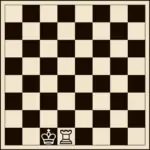This article will focus on queen side castling or long castling, as it’s called. For a more general look at castling on both sides, see the castling FAQ.
Castling Queen Side
Castling on the queen side isn’t seen that much, but it can still be an effective thing to do. Here’s what it looks like:


To castle queen side, the king is moved 2 squares toward the queen side rook. The rook is then placed on the other side of the king.
You’ll notice that the king travels the same distance, 2 squares, regardless of which side it castles on. So why is one side “short” and the other side “long”?
Three reasons: The queen side castle is long because it takes one move longer to clear the spaces between the king and rook. The queen must be moved out of the way, whereas on the king side, it doesn’t. The queen side is also 1 square longer than the king side, again, due to the presence of the queen’s square. This extra distance leaves the king closer to the center of the board after a queen side castle compared to a king side one. Finally, the rook has to move a longer distance, 3 squares instead of 2.
Why Don’t We See More Queen Side Castles?
King side castling is by far the more popular version of the move. There are a few reasons for this:
- You only have to move out 2 pieces—bishop and knight—on the king side to clear your path, so it’s faster than the queen side, where you have to move 3—queen, bishop and knight. (setting up the board)
- The king ends up in a more secure position closer to the edge of the board (1 square away) compared to the queen side (2 squares away).
- The final position of the king and king side rook are more favorable for the more common chess openings.
- A queen side castle leaves the A-pawn, the one by the left edge, unprotected.
When Should We Castle Queen Side?
Castling king side is usually going to be our first choice, but we might go the other way if:
- Our opponent has mounted a strong attack on the king side.
- You want your king closer to the center. If you want to bring your king into the attack, it’s 1 square closer.
- You want your rook more centralized. If pieces have been exchanged and the board is opening up, a queen side castle will activate your rook faster (assuming both sides are available).
In general, king side castling is more defensively sound and efficient. Queen side castling is more offensive, especially if your opponent has castled on the king side. Now, you’re both free to advance your pawns against each other’s king sides.
In the end, the board position will determine which side you should castle on, and it will take experience to recognize the best option. When the position is especially sharp it might not be obvious even to expert level players which side is preferable. As your play improves, you’ll get more confident in choosing your castling side.